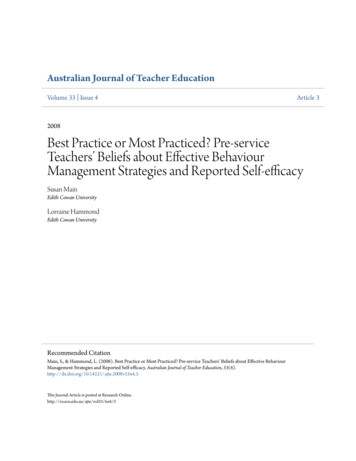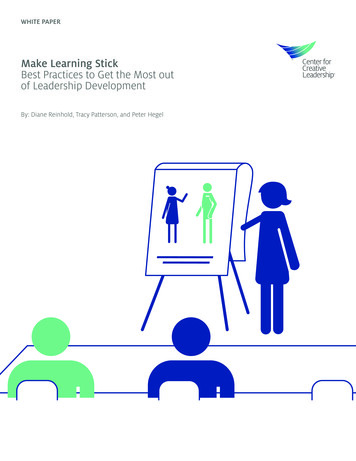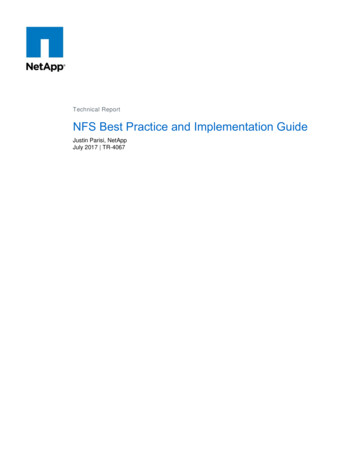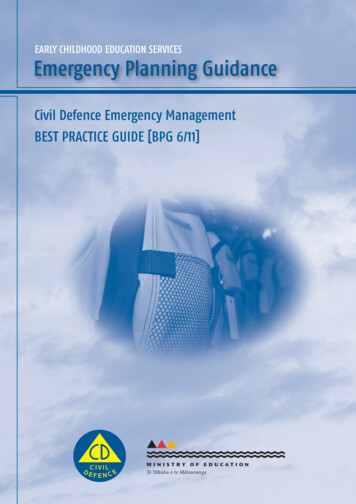
Transcription
Australian Journal of Teacher EducationVolume 33 Issue 4Article 32008Best Practice or Most Practiced? Pre-serviceTeachers’ Beliefs about Effective BehaviourManagement Strategies and Reported Self-efficacySusan MainEdith Cowan UniversityLorraine HammondEdith Cowan UniversityRecommended CitationMain, S., & Hammond, L. (2008). Best Practice or Most Practiced? Pre-service Teachers’ Beliefs about Effective BehaviourManagement Strategies and Reported Self-efficacy. Australian Journal of Teacher Education, his Journal Article is posted at Research Online.http://ro.ecu.edu.au/ajte/vol33/iss4/3
Australian Journal of Teacher EducationBest Practice or Most Practiced? Pre-service Teachers’ Beliefs aboutEffective Behaviour Management Strategies and Reported Selfefficacy.Susan MainLorraine HammondEdith Cowan UniversityAbstract:Managing student behaviour remains one of the mostdaunting aspects of teaching for educators and this isparticularly so when children with disabilities are included inthe regular classroom. Self-efficacy has been identified ashaving a significant impact on a teacher’s behaviour, and preservice training can play an important role in preparingteachers to be effective classroom managers. The purpose ofthis study was to identify if pre-service teachers in anAustralian university held high or low self-efficacy beliefs andwhether the type of strategies they identified as most effectivecorrelated with those highlighted in the research as bestpractice. In addition, pre-service teachers were surveyedbefore and after their practicum in order to determine if actualclassroom experience impacted on their self-efficacy and theirknowledge of behaviour management strategies. Findingsindicated that self-efficacy beliefs among this cohort of preservice teachers were generally high and were even higherafter the practicum. There were concerns, however, that therange of behaviour management strategies identified by preservice teachers was limited and did not incorporate strategiesto deal with more challenging and persistent behaviourproblems.IntroductionBehaviour management is arguably the cornerstone of good teaching and thisis particularly so in inclusive settings, that is, where children with disabilities aretaught alongside their peers without disabilities. In a Western Australian contextstudents with mild to moderate support needs for a range of sensory, physical andintellectual disabilities are included in mainstream classrooms. Children withbehavioural difficulties are often considered to be among the most difficult to includein regular classrooms (Corbett, 2001; Croll & Moses, 2000; Hodkinson, 2006;Scruggs & Mastropieri, 1996) and the more diverse the student population is the moreteachers become concerned about inappropriate behaviour (Blankenship, 1988; Safran& Safran, 1985). With the move toward more inclusive educational practices inWestern Australian schools in the past decade (Pearce & Forlin, 2005), there is theneed to ensure that pre-service teachers are adequately prepared for behaviourmanagement in inclusive classrooms. Put simply, a teacher equipped with effectiveVol 33, 4, August 200828
Australian Journal of Teacher Educationbehaviour management skills is better able to deliver lessons that address the needs ofindividual children (Kounin, 1970).Some of the more challenging behaviours that may be exhibited by childrenwith disabilities have been identified as significant stressors for teachers in inclusivesettings (Forlin, 2001; Forlin, Keen, & Barrett, in press). Not surprisingly, behaviourproblems in the classroom have also been identified as a factor in the retention ofteachers to the profession – an important consideration at a time when the demand forteachers is greater than the supply. The Australian Education Union (2006) nationalsurvey of 1200 beginning teachers identified behaviour management as the secondmost significant concern, after workload, for newly qualified teachers. Further,several studies have identified behaviour problems in the classroom as a significantfactor in the stress and burnout for both novice and experienced teachers(Blankenship, 1988; Griffith, Steptoe, & Cropley, 1999; Martin, Linfoot, &Stephenson, 1999; Schottle & Peltier, 1991). A longitudinal study by Brouwers andTomic (2000) highlighted the relationship between teacher burnout and sense of selfefficacy, reporting that burnout was preceded by low efficacy beliefs in classroommanagement. This finding concurs with previous studies on teachers’ sense of selfefficacy and provides compelling support for the significance of this construct onteacher behaviour.Self-efficacy is conceptualized as the individual’s belief in his or her ability toundertake the actions required to successfully accomplish a specific task in a specificcontext (Bandura, 1986); it is also thought to play an important mediating rolebetween an individual’s knowledge and skills and his or her behaviour (Emmer &Hickman, 1991). Bandura (1997) asserted that beginning teachers with a strong senseof self-efficacy are more willing to pursue challenging goals, have greaterperseverance, and are more resilient in adverse conditions. Self-efficacy has also beenregarded as an indicator of teachers’ willingness to include students with disabilitiesin their classrooms (Meijer & Foster, 1988; Soodak, Podell, & Lehman, 1998).In relation to behaviour management, Martin, Linfoot, and Stephenson (1999)identified teacher’s self-efficacy as a factor in the way in which teachers respond toinappropriate classroom behaviour. Woolfolk, Rosoff, and Hoy (1990) suggested thatteachers who hold high self-efficacy beliefs are more likely to use a range ofbehaviour management techniques. Further highlighting the importance of teacherconfidence, Baker (2005) found that there was a significant correlation “betweenperceived self-efficacy for classroom management and teacher readiness formanaging challenging behaviours” (p.58). This concurs with Buell, Hallam, GamelMcCormick, and Scheer (1999) and Soodak and Podell’s (1993) findings that teacherswith a high sense of self-efficacy hold the belief that difficult students are teachable.Clearly, self-efficacy beliefs about behaviour management can be seen as animportant pre-requisite for inclusive classroom practice as well as a factor in teachers’longevity within the teaching profession.There is now an expectation that novice practitioners will design and delivercurriculum to an increasingly diverse population; however, effective teaching is alsothought to be contingent on effective management of student behaviour. Perhaps theneed to juggle these two requirements is why pre-service teachers in particular havebeen found to be anxious about their ability to manage student behaviour. This islinked with the adequacy of teacher preparation courses in terms of teachers’ sense ofself-efficacy (Latz, 1992) and Tasan (2001). Giallo and Little (2003) go so far as tosuggest that “classroom placement of children with persistent behaviour problemsVol 33, 4, August 200829
Australian Journal of Teacher Educationcould be based upon an assessment of the prospective teachers’ self-efficacy inbehaviour management.” (p.32).Perception and reality are clearly separate issues and whereas educators mayreport that they feel confident managing student behaviour, this may not be reflectedin their practice. Judging effective behaviour management is a complex issue, asevidenced in research by DeJong (2005) aimed at identifying best practice inAustralian schools. DeJong found that many of the approaches that were identified asbest practice “lacked ‘hard’ evidence to substantiate claims of successful outcomes”(p.357). There was, however, the indication that successful approaches werecontingent on key contributing factors, such as the need for teachers to understandbehaviour in relation to the “cycles of interaction” (p.357) and to “embraceinclusiveness” (p.358). DeJong (2005) identified as among best practice, thoseapproaches that acknowledged the interplay of various factors on the behaviour of anindividual. This emphasis on understanding the factors that contribute to, andmaintain, behaviour is also advocated by Snell and Brown (2000) who note the role ofa functional analysis of behaviour when developing positive behaviour support. Afunctional analysis aims to identify the antecedents and consequences of inappropriatebehaviours with a view to modifying either or both of these factors. Positivebehaviour support involves the “redesign of environments” (Snell & Brown, 2000,p.207) so that inappropriate behaviour is replaced by appropriate behaviour. Inutilizing this approach, Snell and Brown (2000) acknowledge the significantcontribution of Applied Behaviour Analysis (ABA) principles to the management ofchallenging behaviours. Indeed, there is considerable research to support the efficacyof ABA in modifying inappropriate behaviour (Alberto & Troutman, 2006), whichmakes this an important inclusion in a teacher’s behaviour management repertoire.The researchers in this study have had extensive experience working withstudents who require teaching and learning adjustments in inclusive school settingsand have been involved in pre-service teacher education for several years. They haveobserved the importance of effective behaviour management on teachers’ ability toimplement appropriate teaching and learning adjustments and are interested ineffective ways to prepare pre-service teachers to manage challenging behaviour in allstudents, including those with disabilities, in inclusive settings. Mindful of previousresearch on behaviour management and self-efficacy, the authors aim to measure theself-efficacy in behaviour management of pre-service teachers in an Australianuniversity and compare this with their knowledge of different behaviour managementstrategies. In other words the study is concerned with the correlation betweenparticipants’ self-efficacy and knowledge of behaviour management strategies andwith their preparedness to manage challenging behaviour.MethodPre-service teachers in their third year of a four year Bachelor of Educationdegree were surveyed to determine their self-efficacy in behaviour management. Inaddition, they were asked to identify the behaviour management strategies theyperceived to be most effective and those that they had observed being used in schools.The survey included demographic data, such as age and gender, questions relating topast experience with children in educational and other settings, and their attitude toinclusive education. Course work in which the pre-service teachers were enrolleddefined inclusive education as classroom settings in which children with disabilitiesVol 33, 4, August 200830
Australian Journal of Teacher Educationare educated together with their peers without disabilities. Questionnaires weredistributed to 155 Kindergarten to Year 7 and 147 Secondary pre-service teachersprior to and after the completion of a four-week practicum. A total of 123 (41%) ofthe pre-service teachers responded to the pre-practicum survey: 43 males and 82females; however, only 69 (23%) responded to the post-practicum survey: 18 malesand 51 females.InstrumentThe instrument for measuring self-efficacy (appendix A) was adapted fromone developed by Baker (2005), which in itself was an adaptation of Brouwers andTomic’s (1999) Teacher Interpersonal Self-Efficacy Scale and of an instrument with amore individualized behavioural perspective by Bullock, Ellis, and Wilson (1994).Advice was sought from professionals in the field of Special Education on theinstrument’s face and content validity. As the emphasis on behaviour management inunits that pre-service teachers had already undertaken was on humanistic andecological approaches, it was felt that further adaptation was required to ensure itsapplicability. Pre-service teachers had had limited exposure to Applied BehaviourAnalysis (ABA) in their course work; therefore, questions relating specifically to thisapproach were removed. The survey was then piloted with five pre-service teachersfrom the cohort, resulting in further minor changes to the descriptive questions, butnone to the self-efficacy scale. It was not possible to conduct a larger scale pilot studyand as such the reliability of the self-efficacy scale had to be established after thesurveys had been administered. Using Cronbach’s alpha, the reliability of the selfefficacy scale was determined to be .881.ResultsThe survey included both qualitative and quantitative data; descriptiveanalysis and inferential statistics were employed in analysing the data. T-tests andone-way ANOVAs were used to explore the impact of specific characteristics onreported self-efficacy, and descriptive data on preferred management techniques werecompiled.Self-EfficacyIn establishing self-efficacy levels it was necessary to determine a cut-offpoint between high and low self-efficacy. Since standard normal distributionrepresentative of an average respondent includes one standard deviation above andbelow the mean (Creswell, 2005), the distinction between high and low self-efficacywas set at one standard deviation (SD .32) below the mean (M 2.89). This total of2.57 was then rounded to 2.6 to establish a value between high and low self-efficacyscores. Therefore, respondents with a mean less than 2.6 were placed in the lowcategory; whereas those with a mean equal to or greater than 2.6 were placed in thehigh category. On the basis of this, the level of self-efficacy for 79% of the prepracticum respondents was in the high category. After practicum, pre-service teachersreported higher levels of self-efficacy (M 3.12) and this reached statisticallysignificant levels t (64) 6.44, p .05 when compared their pre-practicum responses.Vol 33, 4, August 200831
Australian Journal of Teacher EducationPrior to the practicum, pre-service teachers rated highest on the question oftheir ability to use a variety of non-aversive techniques, including voice modulation,facial expressions, planned ignoring and proximity control (M 3.2); post-practicumthey rated highest in their ability to self-evaluate their own teaching and classroommanagement skills and use the results constructively (M 3.4). The pre-serviceteachers’ lowest self-efficacy both pre- and post-practicum was reported on thefollowing two items: a) There are very few students that I cannot handle (pre M 2.5post M 2.9) and b) I can keep defiant students involved in my lessons (pre M 2.5post M 2.8). This was consistent with their response to a discrete question on thepre-practicum survey that asked pre-service teachers about their readiness,willingness and ability (Baker, 2005) to manage challenging behaviours (M 2.4).There was a significant difference between pre-service teachers’ overall sense of selfefficacy and their response to this question F (3,118) 4.660, p .05.Impact of demographicsIt was hypothesized a priori that certain factors would have an impact on anindividual’s self-efficacy; therefore, a number of questions pertaining to demographicinformation and past experience were included. Factors that were thought to berelated to levels of self-efficacy included: type of program, prior experience workingwith children, teaching children with disabilities, gender, and attitude to inclusion.These factors were compared to self-efficacy scores using T-tests and ANOVAs todetermine if there was a significant difference between populations.Pre-service teachers were asked to identify which program they were enrolledin because some studies have found that secondary teachers had a lower sense of selfefficacy than primary teachers (Baker, 2005). Conversely, other studies found nosignificant difference between secondary and primary trained teachers in terms oftheir perceived preparedness to manage behaviour problems (Cains & Brown, 1998).In this study, pre-service teachers who identified themselves as being in the K-7program had a mean self-efficacy score of 2.85 pre and 3.16 post, whereas those inthe Secondary program had a mean score of 2.87 pre and 3.06 post, indicating thatthere was no significant difference in their sense of self-efficacy (Pre t (120) -.321,p .05. Post t (65) .876, p .05).Pre-service teachers who had no prior experience working with children ratedslightly lower in their level of self-efficacy, but this was not statistically significant(F(3,120) .860, p .05), and there was no significant difference between those preservice teachers who are parents and those who are not (t (122) 1.174, p .05).Overall, pre-service teachers reported a positive attitude to inclusive educationalpractices and, whereas the majority responded that children with disabilities requireddifferent behaviour management strategies from other children, this did not impact ontheir reported self-efficacy (t (113) 1.68, p .05). Similarly, having a student with adisability in their class during practicum did not significantly impact on their levels ofself-efficacy (t (64) 1.06, p .05). Interestingly, male pre-service teachers reportedstatistically significantly higher levels of self-efficacy than female pre-serviceteachers prior to practicum, t (123) 2.32, p .05; however, post practicum there wasno significant difference, t (65) .262, p .05.Management techniquesVol 33, 4, August 200832
Australian Journal of Teacher EducationIn addition to self-efficacy and the factors that impact on this, the researcherswere interested in establishing what behaviour management techniques pre-serviceteachers remembered from their course and observed being used in schools. Further,the researchers wanted to know whether the techniques the pre-service teachersperceived to be effective were aligned with those they had been taught about and/orthose they observed. Pre-service teachers indicated that they were exposed to a broadrange of behaviour management strategies and theoretical approaches in their tertiarystudies. The exception to this, as predicted, was about Applied Behaviour Analysis(ABA) and Functional Behavioural Assessment (FBA), with only 6% reportingknowledge of these approaches.In secondary schools the pre-service teachers predominantly reportedobserving timeout, both in class and out of class, followed by the use of proximity. InK-7, timeout was also the most frequently observed approach, with extrinsic rewardsand warning systems, such as putting the student’s name on the board, ranking as thenext most common. Only 30% of the pre-service teachers reported observingIndividual Behaviour Plans or Behaviour Support Plans in use and none listedapproaches aligned with ABA or FBA procedures.The behaviour management strategies that pre-service teachers perceived to bemost effective were closely aligned with those they observed in schools. Secondarypre-service teachers perceived proximity, followed by timeout, to be the mosteffective strategies and also included using discussion with student about theirbehaviour to assist them to make more appropriate choices. K-7 pre-service teachershighlighted extrinsic rewards followed by timeout as the most effective behaviourmanagement strategies. None of the students considered behaviour analysis basedstrategies to be effective for behaviour management.DiscussionThis research revealed a number of factors associated with pre-serviceteachers’ attitude to and perceived self-efficacy in behaviour management. Prior tothe implementation of this study, anecdotal evidence suggested that primary teacherswere more confident about managing behaviour and that having a child with adisability in their classroom challenged pre-service teachers’ beliefs about their abilityin this area. The findings, however, were not consistent with these perceptions. Infact, the majority of the respondents reported high levels of self-efficacy in
in their practice. Judging effective behaviour management is a complex issue, as evidenced in research by DeJong (2005) aimed at identifying best practice in Australian schools. DeJong found that many of the approaches that were identified as best practice “lacked ‘hard’ evidenc











